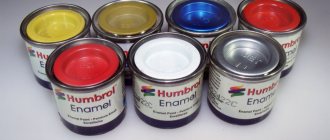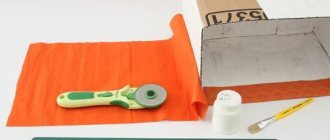The best ways to beautifully hide radiators
There are several ways to hide batteries; in this section we will look at the most popular and effective ones.
Hinged screen
It is by far the most practical and popular method; most often this design is made of metal and has its advantages:
- simple installation;
- heat exchange remains the same;
- can be made with rounded corners, which reduces the risk of injury.
Glass screens
A screen made of glass will be an interesting and stylish solution, especially for those who choose minimalism or a modern style in interior design.
Photo printing or various patterns can be applied to the glass, but this method is not a budget option.
Installation is carried out on a screw holder, but you will have to drill holes in the wall. However, the heating radiator will be stylishly protected. This option will fit into any interior.
Box screens
Box screens are an excellent option for decorating radiators.
- They will help to completely hide the battery.
- The box can become a piece of furniture.
- The screens are easy to install and easy to maintain.
- Protect from burns or other injuries.
Curtains to the floor
Let’s not forget about the most popular way to hide batteries - simply hang them with opaque or translucent curtains. Using this method, over time you will even forget that there are pipes and a radiator behind the curtains.
The main thing is to choose curtains that will look harmonious and not show everyone that there is something behind them.
Painting the walls in color
How to hide a heating radiator on the wall if other designs are “prohibited”. There is only one way to paint it the same color as the wall.
Wood frame
Wood will create coziness and warmth in the apartment, and the disguise of the battery will be elegant and beautiful. This option is for those who are furnishing their home in eco-style using natural materials.
These ways to hide batteries can be used as a stand for home decor.
Built in furniture
Another common way to cover a radiator is custom-made furniture or built-in furniture (shelves, cabinets, folding tables, seating).
Hide the radiator with furniture
Arrange furniture, such as an armchair or desk, so that it covers the radiator. A cast iron radiator is not attractive to many, but pieces of furniture can hide it.
Replace with designer model
For those who don’t want to invent anything, unique designer ways to hide batteries have been developed that already initially have a beautiful appearance and you simply don’t want to hide them.
How to beautifully cover a battery with a screen: materials for decoration
Decorative grilles installed on radiators not only mask heating elements, but also act as protection from small children. They protect them from burns and bruises on the metal parts of the device.
In kindergartens and schools, a wooden fence is often installed on a cast-iron battery, which fits into almost any interior.
When installing screens on a radiator, you need to consider its placement. Deeply hidden in a niche under the window, the batteries can be hidden behind a flat screen. Cast iron radiators protruding forward or located under the window sill are hidden behind attached boxes.
Material for battery screens:
- MDF;
- Metal;
- Drywall;
- Tree;
- Glass.
It is not recommended to use plastic in this case. When heated, the material may deform, which will lead to an unpresentable appearance. In addition, heated plastic releases harmful substances that are unsafe to inhale.
When covering the battery with a screen, you need to take into account the practical side of the issue. A hanging screen made of wood can be adapted into a convenient shelf. Using chipboard sheets, you can mount a low cabinet across the entire width of the room with doors covering the radiator.
Sewing the instruments into a screen made of thick glass with beautiful patterns will delight the eye of even the most fastidious esthete. At the same time, the temperature in the room will drop significantly. Performing its decorative function, the screen blocks the path of warm air.
Beautiful metal grilles with intricate patterns are one of the most common ways to decorate radiators. The more holes in the grille, the more heat enters the room.
Original ideas
There are many creative ideas that can turn batteries into a decorative element:
Forged products
Hide the radiator with fabric
Painting and decoupage of batteries
Decoupage
Selecting and gluing drawings onto the restored surface helps not only to update the battery, but to make it a stylish element of the room’s interior.
Related article: Matt Damon's Incredible Home in Pacific Palisades: All the Rooms Reviewed
If certain rules are followed, updating the battery using the decoupage technique will not be difficult:
- We select materials . To work, you will need multi-layer napkins with designs, a wide brush, glue, and transparent varnish.
- Preparing the surface . The battery must be washed with detergent, unstable paint elements removed, and cleaned with sandpaper. You can start decorating with napkins only after the battery has completely dried.
- We apply decor. Carefully cut out the design from the selected napkins, remove the lower layers of the napkin and, having coated the fragment with glue, press it to the surface of the battery. Using a clean, dry brush, remove air bubbles from under the glued napkin.
- The final stage . Treatment with a special varnish for batteries will help protect the decor of the battery.
Masking of radiators and the laws of heating engineering
The main task of any heating radiator is to heat the room. The goal is achieved by combining or separately using two methods - infrared radiation and convection. Thanks to them, comfortable conditions are formed.
Infrared radiation transfers heat to objects in the room, while convective radiation heats the air.
We can feel thermal energy if we place our hand in close proximity to the radiator. Convection ensures air circulation and uniform temperature distribution throughout the room.
This is known from school physics courses - warm air, rising upward, displaces colder air.
The screen for the radiator performs several important functions: it links the device with the design, protects it from damage and settling dust, the combustion of which releases toxins.
You need to understand that almost any method of hiding pipes and radiators will lead to an inevitable loss of heating power. The simplest example is the use of a glass screen with artistic painting.
It would seem that the task of decorating the radiator was completed successfully, but the room immediately became noticeably colder. This all happened because glass almost completely neutralizes infrared radiation.
An original way to disguise a heating radiator will help to expand the window sill and use the structure as a piece of furniture.
The deeper and more securely the radiator is hidden, the greater the losses will be.
This statement fully applies to blind screens that prevent both long-wave infrared radiation and short-wave convection.
Maximum perforation of the grille and the presence of gaps in the upper and lower parts of the lining are the key to normal convection.
The same can be said about the blind boxes above the top of the radiator - they are an insurmountable barrier to the spread of warm air upward (the convection method does not work). The conclusion suggests itself - the larger the area of the holes in the lining, the smaller the heat loss will be.
Decoration method No. 2
The second method is decoupage of a heating radiator. This method is quite popular, because the result is a stylish product, original and unique. It all depends on your imagination, the materials used and the ability to create the simplest work. So, do-it-yourself decoupage of heating radiators will require some materials:
- Matte white paint.
- Acrylic paints.
- Tassels.
- Decoupage paper with the design you need.
- PVA glue.
- Heat-resistant varnish.
Materials and tools for decoupage of a heating radiator
Decoupage of heating radiators involves following the following stages of work:
- First of all, the surface of the heating devices should be washed and treated with fine sandpaper.
- Now we need to wipe our batteries from dust and dirt, then we paint them with matte paint. You should not use nitro paint, because your batteries were originally coated with oil paint, and if you cover them with nitro paint, they will become covered with bubbles.
- After 18 hours, when the paint has dried, we will begin gluing decoupage paper to the radiators. We dilute the glue so that we can distribute it evenly over the plane. We start gluing from the middle of the motif.
- When the entire drawing is pasted, you can paint whatever you want, make a background and detail the drawing.
- Now we need to cover our drawing with heat-resistant varnish.
DIY decoupage of the heating battery is ready! Now we have stylish batteries that will complement the interior and highlight it. In the photo you can see options for decoupage.
Heating radiators after decoupage
It is worth noting that currently you can choose special stickers for the radiator. Such stickers are created specifically for radiators, so their material tolerates high temperatures well. Stickers and designs on radiators should be chosen from high-quality material so that they do not deteriorate when heated.
Flushing radiators
Requirements for the decoration of heating radiators
The availability of pipes and radiators is another important point in choosing decor after the requirements of heating engineering. It is well known that the heating radiator, namely the connection with the pipe, is the weakest point.
In addition, the radiator itself, due to improper installation and operation, or for a number of other reasons, may leak.
In emergency cases, it may be necessary to remove the radiator for repair or replacement. From a plumbing point of view, the cover or screen should not have a fixed attachment, ideally the use of attached screens.
Even if you decide to ignore the advice of a plumber, still listen to the voice of reason, which suggests that any weak point in the system is the connection nodes. The presence of an inspection (plastic door) can significantly simplify the task of servicing the radiator and heating system in the future.
How to close batteries correctly - technical rules and tips
Before closing the radiator, you need to take into account several technical nuances:
- Keep in mind that the heat transfer of a closed radiator is reduced in any case, no matter what masking method you choose. The main thing is that the change is not significant.
Ideally, the decrease in air temperature in the room should be about 1-1.5 degrees.
- Before closing the battery, put it in order: blow it out, wash it (this is done at the end of the heating season) and paint it.
- Keep in mind that the denser the grille weave, the better it masks the radiator, but the worse it conducts heat. Therefore, when choosing a screen for a battery, try to look for a middle ground or rely on heat saving.
- To minimize heat loss, the screen can be placed on legs and a groove can be cut in the center.
When closing the battery, it is very important not to block convective air flows, otherwise it will blow in the room and the windows will begin to fog up, which will ultimately lead to the appearance of mold on the walls. Ideally, the window sill visor should protrude no more than 30 mm above the radiator; the top and bottom of the radiator should be as open as possible.
- There should be a distance of at least 35-50 mm between the battery and the screen. There should be a gap of about 60-70 mm from the radiator to the floor and to the window sill.
To resolve emergency situations, it is necessary to provide free access to the radiator. For example, the box grille can be removable, folding, opening on hinges or retractable on profiles.
At a minimum, for trouble-free maintenance, the following must remain in good accessibility: pipe connections, valves, thermal head and threaded connections.
You can increase heat transfer by 20-25% by placing a heat-reflecting screen, for example, fumisol, on the wall behind the radiator. Often this is quite enough to completely compensate for the heat loss of a closed battery.
Screens and grilles
When decorating a battery, you can make various screens, grilles, and panels. The main principle is not to completely block the flow of warm air and use materials that do not lose their qualities from high temperatures.
Such structures are made hanging or resting on the floor. A very interesting option for designing a heating radiator with your own hands is to create a screen-box in the form of a narrow bedside table with doors on which you can place a lamp, a vase, and various small items. Long, low (up to the window sill) cabinets, in which radiators will be hidden behind closed panels, and books and various things will be located on open shelves, will also fit well into the interior of the room.
When deciding to create battery decor with your own hands, you should not take plastic, as it conducts heat poorly and warps at high temperatures. The metal has good thermal conductivity, but only a specialist can work with it. Wood is environmentally friendly, but it dries out over time, although it is well suited as an environmentally friendly material.
In homemade screens, the sides can be made of solid wood (plywood, boards, chipboard), and the top and front panels can be made of material with holes for air flow.
In large houses, many apartments do not have the ability to regulate the temperature of radiators. Therefore, in children's rooms, it would be appropriate to hang self-sewn fur covers depicting cute animals on radiators. This will not only look aesthetically pleasing, but will also prevent kids from getting burned on the hot panels.
Hide with drywall
Separately, I would like to talk about how you can hide batteries using drywall. It’s worth noting right away that the material has its drawbacks, but plasterboard construction is still very popular for repairs.
- The material is environmentally friendly and is not subject to combustion.
- You can find several varieties of this material on the market.
- This camouflage option is budget-friendly, and installation can be carried out in different ways, in a way that is convenient for you.
- Also, it is drywall that will allow the apartment owner to come up with any design, which will help not only to cover the pipes and radiator, but also to make additional decorative elements.
The downside is that drywall is afraid of external influences; if you do it carelessly, it is quite easy to break or pierce it.
And if a breakdown or leak occurs, the entire finish will have to be replaced again, but this material is cheap.
Do-it-yourself installation of a plasterboard box
In order to close the battery, you need to measure it, and then buy metal profiles and other additional products.
What materials are needed:
- 12 mm plasterboard sheet,
- metal profiles 27x28 and 60x27,
- self-tapping screws for drywall and metal,
- dowel-nails size 6x40,
- construction serpyanka,
- perforated corners.
Tools:
- screwdriver,
- hammer drill,
- metal scissors,
- stationery knife,
- construction stapler,
- pencil,
- roulette,
- building level.
Attention , for the construction of a plasterboard box there is an important requirement : the window sill must extend beyond the radiator by at least 3 centimeters.
Work order:
Installation of the frame. The profile should be mounted on three adjacent sides: floor, wall, window sill.
- Press the 27x28 metal profile to the base with your hand, drill a hole using a hammer drill in both the profile and the wall.
- Using a screwdriver, screw the dowel-nail into the hole.
- At the bottom of the window sill, a 27x28 metal profile is mounted on self-tapping screws; the length of the screws should not be greater than the thickness of the window sill.
- Next, you can install jumpers made of metal profile 60x27.
Selecting the grid size. This hole must be made slightly smaller than the grid size.
You can focus on three recommended sizes: 60x120, 60x90 or 60x60.
Installation of drywall. Plasterboard sheets can be cut with a utility knife. Screw it in with a screwdriver.
Installation of corners. They must be secured at the corners with a construction stapler, or attached to gypsum plaster.
- Serpyanka should be applied to all seams of the plasterboard box and covered with plaster.
- Before painting or wallpapering, the plasterboard box must be puttied, sanded and coated with primer.
Masking heating pipes
It doesn’t matter whether it’s an apartment or a house, a bedroom or a kitchen, everywhere I would like to have a good renovation. Questions immediately arise: how to beautifully hide heating pipes and how can this be done with minimal cost and maximum efficiency?
At the same time, the method of disguise should be truly invisible and unnoticeable, fitting into the room.
The pipe can be hidden inside the wall, or it can also be closed into the floor. Remember that the old heating system should not be hidden in this way; this option is possible after a complete update of all elements.
Box on frame
It is best made from wood, plastic or plasterboard. Do not place the heating pipes close together; there should be at least three centimeters between the box and the pipe.
Hide behind decor
Decoration of pipes in various ways, for example, wrapping them with jute rope. But remember that this reduces heat transfer. Many owners decorate pipes with flowers; this can be done using bamboo with leaves.
Only imagination should work here; even an old pipe can look completely different.
Painting to match the color of the walls
The easiest and most practical method is to paint the radiators or riser in the same color as the walls, but the heat generation will not be reduced.
Hide under the floor plinth
A good invention was the floor plinth, in which you can easily hide batteries located horizontally and low to the floor.
Making a false wall: how to cover a battery with plasterboard
Installation of a false wall made of plasterboard is possible at the stage of construction or complete redevelopment of the premises. Not only radiators, but also the entire system of heating elements are hidden under the plasterboard wall.
When installing, you need to remember that a plasterboard wall will take up part of the room’s area. If the room is small, the radiators can be hidden behind a box made of the same material.
Drywall sheets are attached with self-tapping screws to special UD and CD profiles. Before proceeding with installation, experts recommend soaking the drywall with several layers of PVA glue.
When constructing a false wall, you need to foresee in advance how to properly organize access to the wiring system and radiators. In addition, they need to be closed so that warm air can still find its way out. The battery protector can be made of wood, plastic or metal.
If it is not possible to cover all the wiring under the false wall, the niche with the battery under the window is sewn up with plasterboard. If desired, you can mount the panel around the entire perimeter of the room. The panel can be covered with wallpaper, painted with water-based paint or covered with wood.
Photos in the interior of the rooms
Kitchen
The kitchen is the ideal room in which all ways to hide batteries will become practical and convenient.
If the room is small, then you can hide the radiator with the help of a beautiful tabletop or make a folding table, which will fold out when convenient.
Factories of metal-plastic structures offer a large selection of beautiful large-sized window sills that imitate stone, wood and other materials. A modern window sill does not break under weight, is not afraid of external factors, is easy to care for, wipe clean, is not afraid of scratches, and so on.
You can hide any type of battery in this way, including cast iron.
Living room
If the radiator is in a niche, then a wide window sill will help create a work area.
You can place souvenirs, vases or potted flowers on the constructed wooden box. You can also cover unsightly radiators in the living room with thick curtains.
The photo shows a modern living room. In order to hide the radiators, a wooden structure was installed, which also serves as a place for rest, storage and decoration.
Bedroom and children's room
In the interior of a bedroom and children's room, batteries can be used as another place to relax, a tabletop for decorative elements or a workplace.
Bathroom
You can hide the pipes in the bathroom using a louvered door, plastic grilles or a cabinet with opening doors.
We hide heating radiators using wooden, glass or plastic screens.
Hallway
For radiators in hallways, glass screens or wooden boxes are suitable. In a small room, covering the battery is only necessary from a practicality point of view.
This could be a locker for storing shoes, or the battery will become a small coffee table where keys and other necessary items will be stored.
Grilles and screens
Flat, hinged, box-shaped, metal, wooden, and plastic screens will help you quickly decorate batteries. Screens and grilles protect radiators from dust and prevent possible accidents if they fall near the battery.
Important: natural heat exchange in a room can be effectively preserved if there are a sufficient number of holes on the surface of the decorative screen.
Let's consider the simplest way to decorate a battery - using a lattice shield.
Algorithm of actions:
- We prepare materials:
- chipboards (color harmonizing with the interior);
- metal mesh;
- fastening elements (dowels, staples, screws, corners);
- hacksaw for wood and metal;
- glue, sandpaper.
- We take measurements. We measure the height and width of the radiator. We increase the indicators by 5 and 10 cm, respectively. The battery depth indicator increases by 2.5 cm.
- We cut out the details of the shield . Using the width and height measurements, cut out a piece of metal mesh. Elements of the future frame that frame the mesh are cut out of MDF boards. Four strips for the facade and four for the lid. We cut all the planks at an angle of 45C and sand them with sandpaper.
- Assembling the shield . We connect the four planks of the facade together, coat them with glue and fix them with self-tapping screws. We also assemble the lid frame. We connect the finished parts together using corners, and fix the mesh cut to size on the inside.
- We mount the shield . The easiest way is to fix the finished shield on the wall using dowels with hooks. To do this, place the shield against the wall and mark the place where it will hang. At these points, holes are made and dowels with hooks are inserted, on which the box will be hung.
Related Article: Stylish Home Office Decor Ideas
The variety of ways to disguise a battery allows you to choose the simplest and most affordable design that matches your existing interior.
How to hide or decorate a battery with your own hands: decoupage, painting, grilles and screens for the radiator (1 video)
Battery decor (8 photos)
The best posts
- [Plants in the house] Zamioculcas or dollar tree: care at home
- Mikhail Shufutinsky [review of housing in Russia and abroad]
- [Plants in the house] How to care for Amaryllis at home?
- Russian video blogger Yuri Dud: review of the interior in a Moscow apartment
- Room decor from old jeans
- Do-it-yourself rabbit cage: how to make a beautiful and comfortable home?
- 7 interior life hacks for children's rooms
- How to hang curtains: 6 main rules
How to beautifully decorate radiators
Installing a decorative box to cover heating radiators is not the only solution, and not everyone can come up with something and do it on their own.
There are several more ways on how and with what to decorate radiators under the window.
Radiator painting
One of the important issues in decorating a room is the combination of colors. Well, how can a white radiator look, for example, on a dark wall? Although for some reason white color is considered ideal for batteries...
The choice of heat-resistant paints on the modern construction market is huge; all that remains is to choose the right shade and tint the white base.
Even if you don’t guess the shade by a couple of tones, it’s okay, such a difference seems not noticeable at all. But it will still be better than just white. Well, if you wish, you can also manually paint the batteries, especially if there is an ornament on the wallpaper. To make the work easier, you can use a stencil.
Remember: if you decide to paint the radiators in your apartment, buy only heat-resistant paints.
By the way, you can paint not only ordinary cast iron radiators, but also steel, bimetallic, and aluminum ones.
Fabric screen
Another decor option is sewing and attaching a fabric screen screen. This masking method has been tested and is quite effective in terms of minimal heat loss, since the fabric, even the densest, still allows warm air to pass through (unlike a hard screen).
Previously, when heavy curtains were in fashion, all the radiators and the pipes suitable for them were hidden behind them.
And now, when Roman or roller blinds that do not reach the floor are used everywhere, we have to invent something. A practical solution is to attach Velcro to the bottom of the window sill and sew the other half of the adhesive tape to the fabric to create a removable fabric screen.
You can choose the material for it according to your taste and financial capabilities - from thin curtains, to natural linen or cotton, or vertical strips of blinds. The only condition is that the fabric can withstand temperatures up to 60 degrees.
Well, having arranged the space under the window in this way, you can choose roller blinds or window blinds as protection from the sun, without worrying about the unsightly appearance of radiators.
Heating battery box
Most often, such structures are either mounted on the wall or are attached, making it easier to maintain communications. Such boxes are made mainly from MDF, chipboard, wood or plywood.
The first option is the most practical, since MDF does not dry out and is not exposed to temperature changes, and it can be given any shape.
A prerequisite for such a design is the presence of perforations (holes), and the larger they are, the more heat will enter the room. There must be a hole at the bottom for the influx of cold air, and at the top for the exit of warm air.
You can use ordinary wooden blocks as a frame for the box, and if you have the skills of a carpenter, you can build a box according to individual dimensions: it can be either a structure the entire width of the room, covering both the radiator and pipes, or a box covering only the radiator.
Usually, the installation of a box that hides radiators is accompanied by dusty work, so you need to think through the design and create a sketch at the beginning of the repair. A decorative box can not only hide nondescript radiators that are unnecessary to the eye, but also become an element of interior decoration.
Hard screen
The most common (but, unfortunately, not the most practical) solution is to install a hard screen; hardware stores even offer ready-made solutions from a variety of materials. Each of them has its own disadvantages and advantages over others.
- Made of metal. For production, as a rule, stainless steel is used, followed by painting or chrome elements. Such structures look like ordinary mesh boxes. Of course, a metal object under the window is not suitable for every room; the ideal style for such a solution is hi-tech or loft.
But this design conducts heat well and will last a long time.
- Made of wood. Wood has always been considered a win-win option, as it fits into almost any interior. Wooden screens are a structure in the form of wooden lamella panels, horizontal or vertical, located at a sufficient distance from each other. Thanks to good perforation, such a grille does not interfere with proper convection; a wooden screen for a heating radiator will be a reasonable solution.
The only condition is that it must fit perfectly into the environment. This can be achieved by making a custom-made design with tinting to match the furniture.
- Made from glass, it will fit perfectly into the interior of any room. The glass can be frosted or colored, almost completely covering the radiator, or it can have a pattern that matches the style of the room. However, along with the elegant and airy appearance, there is one huge drawback - heat loss in the absence of perforation will almost double. Even the thermal gap at the top and bottom of the screen does not help the situation.
You can improve air circulation by using not solid glass, but glass panels located at some distance from each other.
- From plasterboard. Of course, we are talking, rather, about drywall as the basis of the screen itself, and with the help of other materials you can make a decorative panel-overlay that covers the batteries flush with the box itself.
When installing such a structure, you need to remember all the laws of heating engineering and safety, leaving access to communications in the event of a leak or the need to replace batteries.
How to decorate heating radiators: designer tips
The problem of how to hide a heating radiator and a pipe supplying coolant in an apartment can be considered in two aspects. The first is on the eve of a major overhaul, when it is possible (and necessary) to replace the battery. In this case, you can select and install designer batteries and then the issue will disappear by itself, and the heating efficiency will not decrease (more on this below). For example, if we are talking about a room in a classic Victorian style, then you cannot do without cast iron radiators, powerful, massive, on a stand, with casting in sections - such radiators will become a stylish detail of the overall interior.
Combining the battery box and shelves into a single structure
Beautiful decorative box
Hanging wooden screen for a heating radiator in a modern interior
Another thing is when the repair does not involve replacing the plumbing, in this case there are several options for how and with what to close the battery.
Examples in different interior styles
Modern style
For a modern style or a high-tech and minimalist style, any material made of wood, glass (glass panels) or metal is suitable.
Classic style
It is recommended to use natural materials; it is better to opt for a wooden lattice.
Provence
Wood also loves styles such as Provence, country, chalet and eco-style.
Scandinavian
Wooden grilles in light colors will look appropriate in the Scandinavian style.
Loft
In the loft style, old radiators and pipes are most often not covered; they are left on display or replaced with interesting design options.











